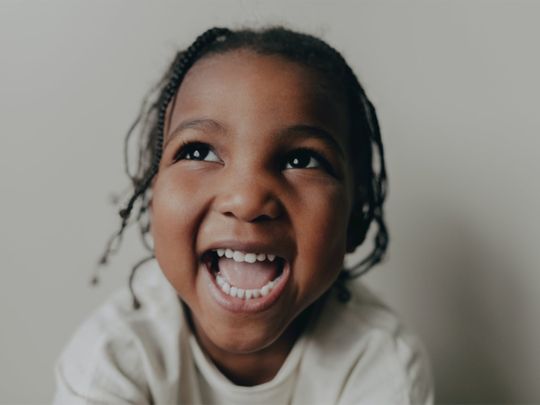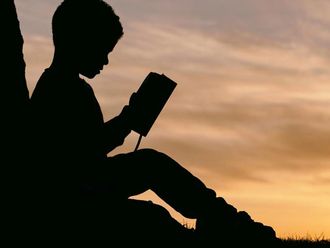
“Mine”, says my baby nephew, his little face stressed as he pulls his beloved stuffed shark plushie back from his sister. This is a snapshot from three years ago, when he wasn’t the larger-than-life dinosaur devotee and untameable spirit he is now, but that was part of the journey. Entering the famous ‘terrible twos’, your toddler will not only be starting to understand ideas of possession but will also embark on a journey of independence, starting to run and climb as well.
Gulf News speaks to Dr Afra Jamal Ahli, Specialist in Family Medicine and Fellow in Maternal and Child Health at Dubai Health Authority, for the milestones to watch out for as a parent when your child hits two years.

The maximum time I wait for walking as a physician is 24 months. By 24 months if they are not able to walk steadily or stand that means that there is a problem that maybe the child is having a genetic muscular problem which is not showing that I really need to investigate.
Social and emotional development milestones for a two-year-old
1. Excited to play with other children
By two years old, they get excited when playing with other children. They play by themselves alongside other children, also called parallel play, and now are expected to show more interest in directly engaging with others in interactive play.
2. Showing more independence
They will start to carry out more actions on their own – for example, washing their hands, and taking their own plates.
3. Displaying defiant behaviour
Dr Afra says, “They show defiant behaviour, especially if you try to tell them not to do a certain thing.”
4. Copies others (adults and older children)
At this age, your child’s imitation is more pronounced, and they will try to copy your words, hand gestures and actions.
Language and communication milestones for a two-year-old
1. Saying 2- to 4-word sentences
According to Dr Afra, toddlers should be able to say 2- to 4-word sentences in their language.
She says, “By 18 months, children should be able to say ‘no mama’ or baba. If they want to say I want water, but they wouldn’t say ‘I want water’ – they would say, ‘I water’.”
2. Following simple instructions
Following simple requests should continue at this age, and test your child’s abilities by asking them to perform different tasks.
3. Repeating overheard words
“They repeat words overheard in conversations, so that they can develop their own language, especially if it is interesting to them,” says Dr Afra.
4. Knows names of familiar people, body parts and things
At this age, names of known people and things should come easily to your baby.
Cognitive milestones for a two-year-old
1. Finding hidden things
They try to find hidden objects: For example, if you hide their bedtime storybooks under the blanket, even if under two or three layers, they should try to find them.
2. Sorting colours and shapes
On a Lego board, for example, your toddler should be able to sort blocks of different shapes and colours.
3. Building a tower of at least four blocks
They should be able to build a tower of 4 blocks or more. Dr Afra emphasises, “The least is four blocks.”
4. Following two-step instructions
At this age, you can issue two-step instructions to your child – such as ‘pick up your cup and bring it the kitchen”.
5. Completes rhymes and sentences in familiar books
“Twinkle, twinkle little star..?”
If a household favourite, at two years, your little one should be able to answer in glee.
6. Names items in a picture book
Whether it’s Tom or Jerry, Scooby doo or real animals, your toddler is expected to identify whether they are a cat or dog, for example, from the picture book.
7. Plays simple make-believe games
Zooming around the house as a fast car, pretending to set up camp, cooking or being a dinosaur are few examples of make-believe games your child can be playing now.
Physical development milestones for a two-year-old
1. Standing on tiptoe
Developing the ability to stand on tiptoe is an important milestone for motor skills.
2. Kicking a ball
At the beach, in your park or backyard, your child should be able to start playing with a ball.
3. Running and climbing up and down stairs
Your child will be able to start running and using stairs properly at this age.
4. Climbing up and down from furniture
Climbing helps develop their motor and cognitive skills.
5. Throws ball overhead
At two years old, your baby is expected to throw balls overhead.
6. Copies or makes straight lines and circles
Scribbling begins to become more complex, and your toddler should draw straight lines and circles at this age.
The maximum period to wait for walking
Dr Afra says, “The maximum time I wait for walking as a physician is 24 months. By 24 months if they are not able to walk steadily or stand that means that there is a problem that maybe the child is having a genetic muscular problem which is not showing that I really need to investigate.”
What are some ways for a parent to best support development at this age?
Dr Afra says that trying to find specific time to spend with your child - playing in the park, visiting other people’s places, playing with other children, giving your child instructions and checking to see whether they understand or not are all important.
She adds, “Reading a book is very important as well – they do understand, they like to see photos, because they can understand actions through the pictures they see.”
- The writer is an intern with Gulf News.








